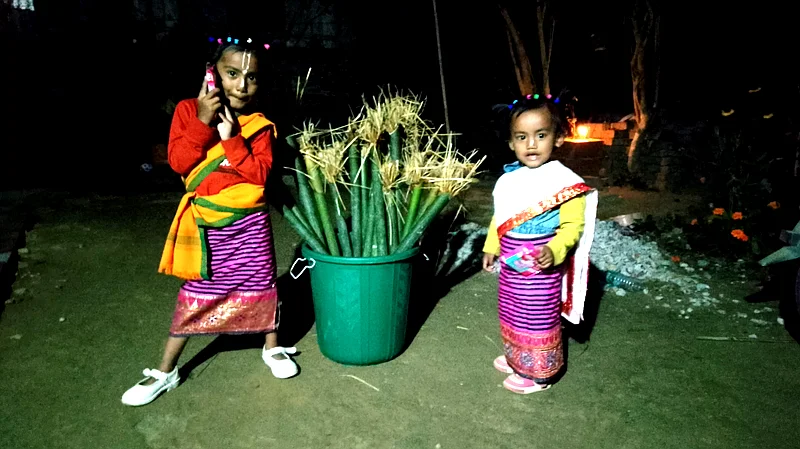Utong Chak: Bishnupriya Manipuri Traditional seasoal food:
In the tiny villages of northeast India, members of the Bishnupriya Manipuri community wherever exists are keeping alive an ancient culinary tradition: Utong Chak, sticky rice slow‑cooked inside bamboo tubes. This impressive dish combines simplicity, sustainability and culture with each bite. In this post, we look at Utong-Chak’s origins, cultural significance, fine preparation, nutritional values and its links to other bamboo rice specialties across nearby countries.
Utong Chak is a prominent part of Makar Sankranti. When families come together to celebrate the harvest festival, this bamboo-cooked sticky rice is a beloved treat, representing warmth, culture and family. The process of preparing it is as meaningful as the dish itself.
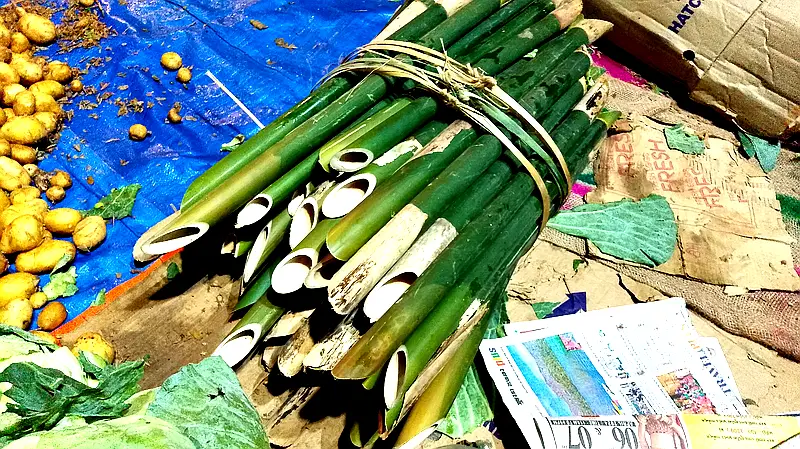
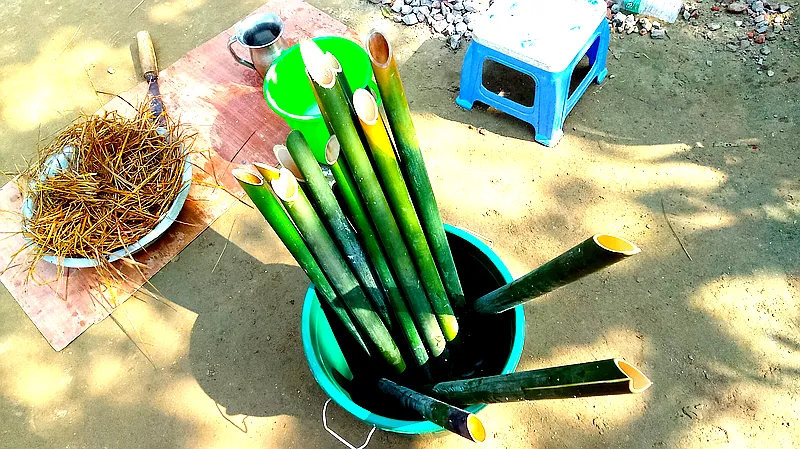
History of Utong Chak Bamboo Rice:
Though the exact age of Utong Chak is undocumented, local oral histories indicate its origins stretch back hundreds of years. At a time when traveling pilgrims required lightweight, long-lasting provisions, rice enclosed in bamboo tubes made for a portable, self‑sufficient meal. Over the years, this practical solution became a celebratory dish served during festivals, harvests and community feasts. Today, Utong Chak is a testament to creativity and balance.
Cultural Significance of Bamboo Rice:
Bamboo Rice has great significance in Bishnupriya Manipuri society:
- Social Bonds: Utong Chak is either cooked after neighbours and families exchange this delicacy during Lai Haraoba and Ningol Chakouba festivals.
- Nature Respect: Cooked in bamboo, a plentiful choice in the area, it also enhances flavors and embodies a zero‑waste approach and respect toward natural resources.
- Heritage Transmission: Elder members pass down bamboo dish practices, rice preparation and fire management to younger generations, ensuring cultural continuity.
Ingredients Overview
Bamboo Rice is based on a few ingredients – all of which were selected for their natural availability and their balance with one another:
- Glutinous (Sticky) Rice: The main ingredient; its starchy content creates a soft and cohesive texture.
- Salt: A pinch to accent the rice’s natural sweetness.
- Sugar or Palm Jaggery (Optional): Only a little can be included in festival variants.
- Bamboo Tubes: New branch, 2–3 in. in diameter, fresh 2–3 ft long, for cooking.
- Bamboo Ends Lids: Sealing the ends of the bamboo, commonly made from banana leaves or natural fiber strips.
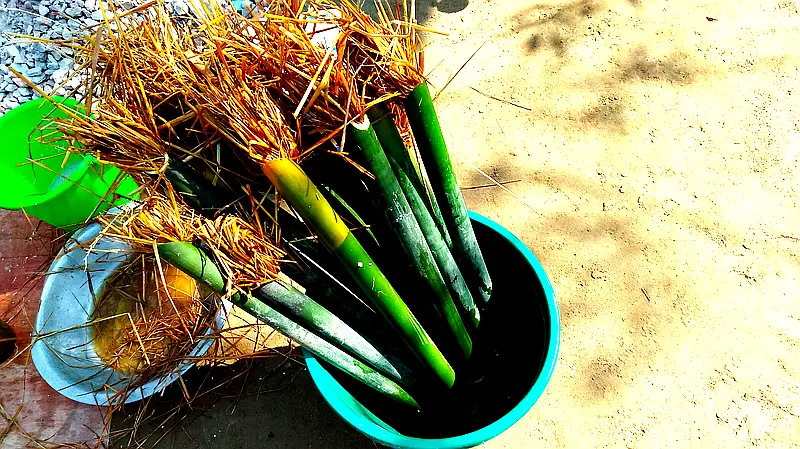
Step‑by‑Step Preparation:
- Bamboo Preparation: Choose tender, fresh tubes of bamboo and wash with clean water 2-3 times.
- Rice Soaking: Wash 1-2 Kgs of glutinous rice under running water until the water runs clear. Also let it soak in clean water for 4–6 hours.
- Filling the Bamboo: Compress the sticky rice tightly into the bamboo tube, leaving about 1 inch empty at the top to accommodate expansion.
- Close the tube tightly: Use cleaned rice straw to close the opening tightly.
Cooking Method:
- Set the filled bamboo tube upright into a bed of fire of rice straw.
- Rotate every 1–2 minutes to distribute heat. Keep the flame gentle – if the flame is too high, the bamboo will burn before the rice cooks and if its very low, the rice will be only partially cooked.
- Cook for 10–15 minutes, or until you smell a sweet, toasty aroma and start to see light charring on the bamboo exterior.
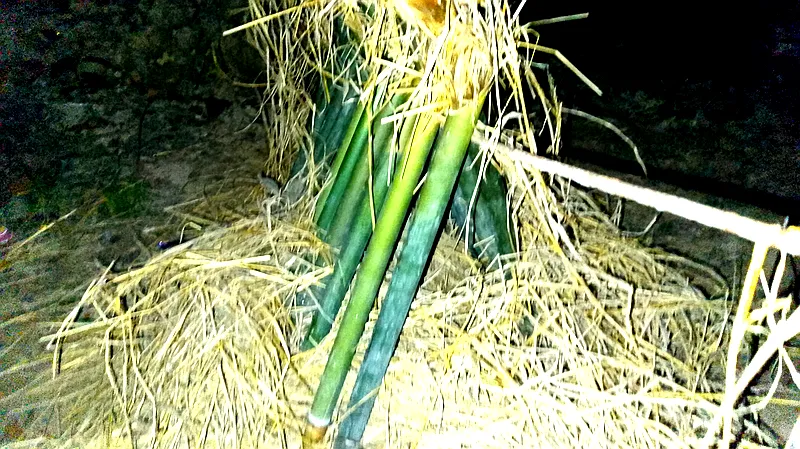

Serving:
- Broke open bamboo – Carefully press the bamboo tube and peel away the bamboo parts – the sticky rice will come out.
- Check out this Utong Chak Preparation Video for a visual guide.
Nutritional Benefits
Utong Chak is a treat for the palate & it nurtures the body:
- Long-Lasting Energy: Glutinous rice is high in complex carbohydrates, providing long‑lasting energy for everyday tasks.
- Few Additives: As bamboos use lowers rice cooking within the bamboos there are few or no oils or artificial enhancers and you would be able to preserve the particular nutrient profile of the rice.
- Digestive-Friendly: Slow steaming breaks down starches, so the rice is easy on the digestive system.
- Low Glycemic Response: Sticky rice and slow cooking create a relatively low glycemic response.
Nutritional Value of Utong Chak (per 100g):
Utong Chak, also known as sticky rice, is a traditional superfood in Bishnupriya Manipuri households. It’s valued not just for its cultural significance but also for its energy-boosting nutrients.
Now, here is the approximate averages of nutritional value of Utong Chak (per 100g):
| Nutrient | Amount per 100 g |
|---|---|
| Energy | 97 kcal |
| Carbohydrates | 21.09 g |
| Protein | 2.02 g |
| Total Fat | 0.19 g |
| Dietary Fiber | 1.0 g |
| Sugars | 0.05 g |
| Calcium | 2 mg |
| Iron | 0.14 mg |
| Potassium | 10 mg |
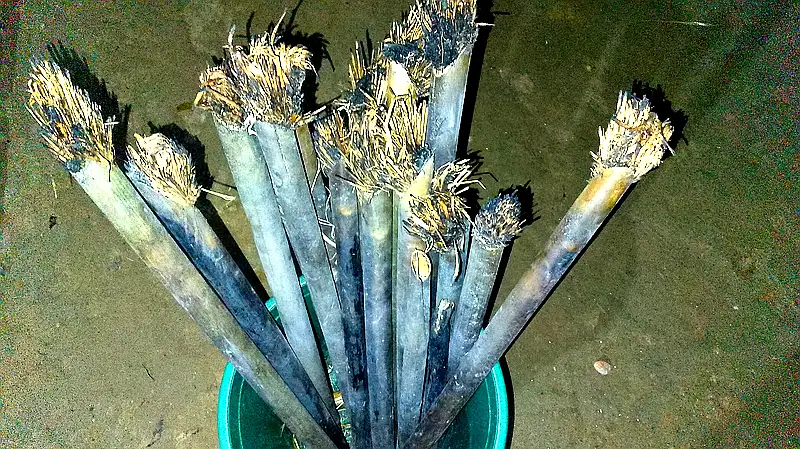
7 life-changing benefits of Utong Chak:
Let’s explore the 7 life-changing benefits of this traditional and why it deserves a place in your diet.
1. High in probiotics for gut health:
Utong Chak is a fermented dish, so it’s full of probiotics – good bacteria that helps keep your gut healthy. Regular consumption improves digestion, reduces bloating and improves nutrient absorption, helping your digestive system function at its best.
2. Boosts Immunity:
Bamboo rice is also rich in vitamins, minerals and antioxidants, Utong-Chak boosts your immune system. The natural fermentation process increases its nutritional profile and assists your body in developing resistance to disease and infection.
3. Supports Weight Loss:
Low-calorie and high-fiber, Utong Chak is great for a weight-loss diet. The fiber content helps to keep you fuller for longer, thus limiting mindless snacking and contributing to healthy weight management.
4. Promotes Heart Health:
It is potassium rich and low in sodium – Heart-friendly. It helps lower blood pressure, helps to reduce cholesterol levels and supports cardiovascular health overall.
5. Improves Bone Strength:
It is rich in calcium and magnesium, which help to build strong bones and prevent osteoporosis. Utong-Chak in your diet can keep your bones healthy and strong.
6. Enhances Skin Health:
Utong-Chak also contains antioxidants that fight away free radicals, leading to reduced oxidative stress, helping achieve healthy, radiant skin. Its anti-inflammatory qualities can also quell skin conditions, such as acne and eczema.
7. Sustains Energy Levels:
Utong-Chak has complex carbohydrates and nutrient-rich profile that gives you a boost of energy naturally. This will provide a slow release of energy, giving you energy and alertness throughout the day.
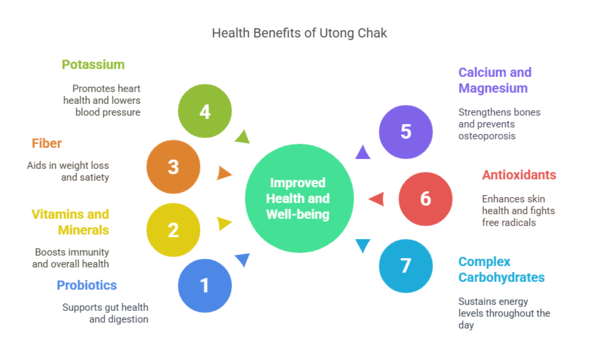
Final Thoughts: Tradition and Sustainability
The custom of cooking rice in bamboo is not limited to a single community – it’s a beautiful practice shared by various tribes and regions. In Northeast India, bamboo rice is also prepared by tribes like Nagas, Mizos and Garos during festivals and special occasions.
Outside India, the tradition exists in countries such as Thailand, Laos, Philipines, Vietnam and even in parts of China, where people also make bamboo-cooked sticky rice, sometimes with coconut milk or beans. It’s a reminder of how nature and tradition converge around the world.
Utong-Chak Bamboo rice shows how a few more or less insignificant ingredients – sticky rice, bamboo tube can yield a dish potent with flavor, nutrition and cultural resonance. Cooking rice in the hollow of bamboo, the Bishnupriya Manipuri community embraces a zero‑waste philosophy, community harmony and centuries of wisdom. We are food lovers and culture keepers, so when you embrace Utong-Chak, you are not just eating a meal – you are taking part in a living tradition that pays homage to people, planet and heritage.
FAQs About Utong Chak:
1. What is Utong Chak?
Utong Chak – a traditional dish or cultural element (depende da contexto) Its flavors, methods of preparation and social importance are well-known.
2. Utong Chak is from where?
For example, Utong Chak especially found in northeast India. They are an integral part of local food and are usually made during festivals or special occasions.
3. What is the principal ingredient for Utong Chak?
Utong Chak is made from sticky rice. It is famous for being simple and containing fresh and local ingredients.
4. How is Utong Chak prepared?
Utong Chak is made by cooking sticky rice filled bamboo tubes on fire.
5. What is the flavour of Utong Chak?
Utong Chak/bamboo rice has an distinct taste, flavor profile, with a touch of dry flavour. Often served with side dishes, e.g., chutney, pickles Paltoi, Juggery sweets.
6. is Utong-Chak vegetarian / vegan?
Yes, Utong Chak is usually vegetarian/vegan because it contains no animal products. In these cases, regional variations may include non-vegetarian components as side dishes.
7. What is the cultural significance behind Utong Chak?
Utong Chak is a traditional dish of Bishnupriya Manipuri culture or northeast region and it is an important part of their cultural heritage. Preferred to be prepared in festivals, marriages or community functions as it symbolizes a core follow to its ancient tradition.
8. Is Utong Chak available in restaurants?
Utong Chak is served at local restaurants and eateries in northeast region. The most traditional farcha, however, comes out at home and festive periods.
9. How to prepare Utong Chak at home?
To prepare Bamboo rice at home, you would need few ingredients and utensils.
Follow these steps:
1. Wash, soak the rice.
2. Combine the ingredients in a bamboo tube.
3. Steam or cook until done, etc.
Serve hot with Juggery Sweets, Paltoi etc.
10. What are the health benefits of exudative Phlebitis?
This makes Utong Chak a nutritious and healthy dish, which is full of different nutrients, e.g., fiber, vitamins, or antioxidants. It is low in fat and usually gluten free, so it can be eaten by the health conscious.
11. In which region is Utong Chak available?
Mostly in Asian countries, in India Northeast region.
12. When should Utong Chak be consumed?
Utong Chak is most popular during winter on Makar Sankranti or Poush Sankranti. Still, it can be enjoyed at any point throughout the year as a satisfying and mouthwatering meal.
13. And is Utong Chak something you can save it for later?
Apsolutely yes, Utong Chak can be stored in airtight container for the refrigerator for 2-3 days. Reheat it slowly before serving to keep its flavors and texture intact.
14. What is Utong Chak and where to learn more?
Discover the highlights of his show in This One’s For You: The Dinner Party on their website or blog, or head to cultural centers in your area that serve this traditional dish; connect with local communities in your town or region that keep this dish alive!

